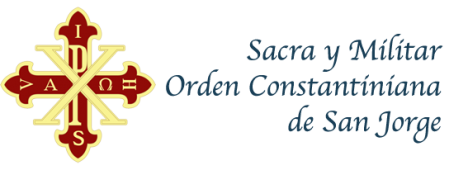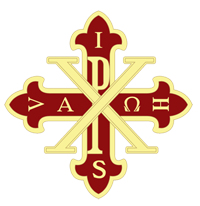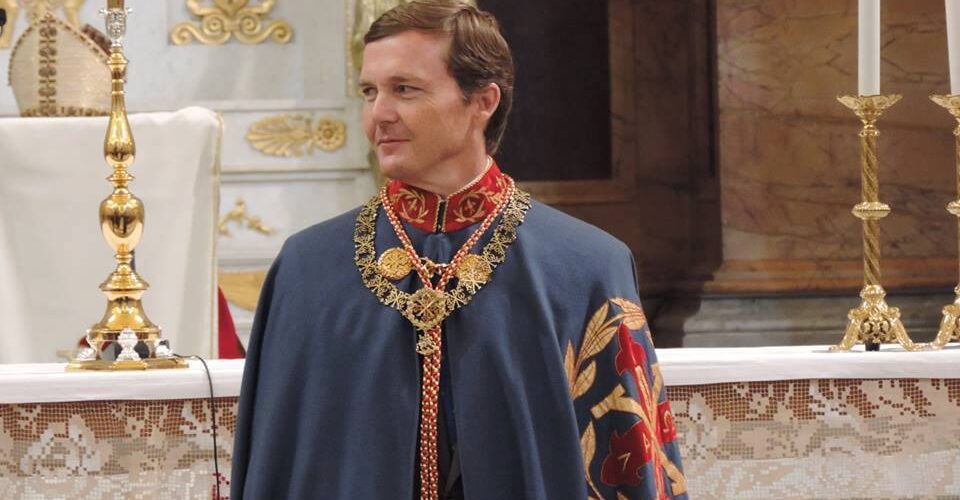The Constantinian Order today
The Constantinian Order is a religious institution, dedicated to promote assistance, humanitarian, cultural and patrimonial actions in accordance with Christian principles. The Constantinian Order aspires to influence today’s world through charity, in areas such as assistance to people threatened by poverty, exclusion, war, or those who are persecuted for their confession, as well as in the promotion of Culture as tangible and intangible heritage.
The Constantinian Order is a religious, neutral and apolitical institution, dedicated to promote assistance, humanitarian, cultural and patrimonial actions in accordance with Christian principles. The Constantinian Order aspires to influence today’s world through charity, in areas such as assistance to people threatened by poverty, exclusion, war, or those who are persecuted for their confession, as well as in the promotion of Culture as tangible and intangible heritage.
The Constantinian Order is one of the oldest equestrian-religious orders of international scope of which today they remain active in the world. Established in the XI century in the East Roman Empire and recognized as a religious order by the Catholic Church since the XVI century, the Order established its headquarters in Italy for more than three centuries. Currently with the headquarters of its Great Magisterium in Spain, it has more than 3,000 members (knights, ladies and ecclesiastics) organized in 9 National Commissions in countries of Europe and America. Maintaining relationship with much states of the world in which it is present, particularly The Holy See, the Kingdom of Spain and the Italian Republic.
Knights, Ladies and Ecclesiastics
The Constantinian Order is composed by Knights Ladies and Ecclesiastics. The four classes of the Order are Justice, Jure Sanguinis (formerly Grace), Merit and finally Office. Each class is divided into the grades of Knight or Lady Grand Cross and Knight or Lady. The dignity of Bailiff can be granted to the Knights Great Cross of Justice, but excluding Cardinals and Royal Princes who are always Bailiff Grand Cross, their number is limited to fifty (in memory of the tradition of the fifty guardians of the Labarum of Constantine), while the number of other great crosses in the three classes is limited to one hundred and fifty knights and seventy-five ladies.
Ladies were first admitted to the Order by a statutory reform in 1908 (although a lady had been admitted before). Today each grade and category is open to ladies except for the Bailiff. All members of the Order must profess the Catholic, Apostolic and Roman Religion and possess the “qualities and virtues of the perfect Christian knight”. By a recent reform, non-Catholics may be distinguished with the Constantinian Cross of Honor, but they do not become knights or ladies of the Order.
The Grand Master also retain the right to confer the Silver Star on knights or ladies of Merit, elevating them to a rank above the other knights of that grade (formerly known as the “Commander”), and the Gold Star to knights or ladies Jure Sanguinis.
According to the 1934 Statutes, amended in 1943 and reinforced in 1968, the aim of the Order is “to glorify the Cross, to spread the Faith and the defense the Holy Roman Church,” and it is required that the knights “live as Perfect Christians … participate in every manifestation which contributes to the principles of religion among people and cooperate with all who revive the practice of Christianity … as well as must dedicate themselves to the two greatest and most important social works, such as hospital care and the charity”.
Some prominent members of the Constantinian Order
SAINTS AND BLESSEDS
Saint Charles Borromeo, Cardinal Protector of the Order
Saint Eugene de Mazenod (Charles-Joseph-Eugene de Mazenod)
Venerable Mons. Eugenio Pacelli, later HH Pope Pius XII
Venerable Placido Baccher de Gasaro
Venerable Mons. Pietro La Fontaine
SOVEREIGNS, HEADS OF STATE AND HEADS OF ROYAL HOUSES
H.M. The King D. Juan Carlos of Spain
H.M. The Queen Dª Sofía of Spain
H.M. Constantin II of Greece, King of the Hellenes (K. of Honour)
H.M. Simeon II, King of Bulgaria (K. of Honour)
Fra Giacomo Dalla Torre del Tempio di Sanguinetto, Grand Master of the Sovereign Order of Malta
H.R.H. D. Duarte of Bragança, Duke of Bragança, Head of Royal House of Portugal
H.R.H. Alexander Karadjordjevich, Head of the Royal House of Yugoslavia (K. of Honour)
PRINCES
H.R.H. The Prince D. James of the Two Sicilies, Duke of Noto
H.R.H. The Princess Dª Sophie of the Two Sicilies, Duchess of Calabria
H.R.H. The Princess Anne of France, Dowager Duchess of Calabria
H.R.H. Dª Theresa of Bourbon-Two Sicilies, Princess of the Two-Sicilies
H.R.H. Dª Inés of Bourbon-Two Sicilies, Princess of the Two-Sicilies
H.R.H. Dª Maria Christina of Bourbon-Two Sicilies, Princess of the Two-Sicilies
H.I. & R.H. Dª Maria of Bourbon-Two Sicilies, Archduchess of Austria, Princess of the Two-Sicilies
H.R.H. Dª Inés of Bourbon-Two Sicilies, Princess of the Two-Sicilies
H.R.H. Dª Victoria of Bourbon-Two Sicilies, Princess of the Two-Sicilies
H.R.H. Dª Pilar of Bourbon, Infanta of Spain, Duchess of Badajoz
H.R.H. Dª Margarita of Bourbon, Infanta of Spain, Duchess of Soria and Hernani
H.I. & R.H. The Archduke Simeon of Austria, Royal Prince of Hungary and Bohemia
H.I. & R.H. The Archduke István Francis Leopold of Austria, Royal Prince of Hungary and Bohemia
H.I. & R.H. The Archduke Joseph Charles of Austria, Royal Prince of Hungary and Bohemia
H.I. & R.H. The Archduke Charles Peter of Austria, Royal Prince of Hungary and Bohemia
H.I. & R.H. The Archduke John of Austria, Royal Prince of Hungary and Bohemia
H.I. & R.H.El Archiduque Ludwig of Austria, Royal Prince of Hungary and Bohemia
H.R.H. The Infante D. Miguel de Bragança, Duke of Viseu
H.R.H. The Prince Charles Emmanuel of Bourbon-Parme, prince of Parma, Piacenza and Guastalla
H.R.H. The Prince Francis William of Hohenzollern, prince of Prusia (K. of Honour)
H.S.H. The Princess Benigna of Reuß
H.H. Edward of Anhalt, Duke of Anhalt (K. of Honour)
H.Em. Cardinal D. Darío Castrillón Hoyos, Prefect Emeritus of the Congregation of the Clergy
H.Em. Cardinal Gerhard Ludwig Müller, Prefect Emeritus of the Congregation for the Doctrine of the Faith
H.Em. Cardinal D. Giovanni Battista Re, Prefect Emeritus of the Congregation for the Bishops
H.Em. Cardinal D. Gianfranco Ravasi, President of the Pontifical Council of the Culture
H.Em. Cardinal D. Carlos Osoro Sierra, Archbishop of Madrid
H.Em. Cardinal D. Antonio Cañizares Llovera, Archbishop of Valencia
H.Em. Cardinal D. Eduardo Martínez Somalo, Camarlingue of the Apostolic Chamber
H.Em. Cardinal D. Antonio María Rouco Varela, Archbishop Emeritus of Madrid
H.Em. Cardinal D. Carlos Amigo Vallejo, Archbishop Emeritus of Sevilla
H.Em. Cardinal D. José Manuel Estepa Llaurens
H.Em. Cardinal D. Manuel Monteiro de Castro
H.Em. Cardinal Dominik Cardenal Duka, Archbishop of Praga








